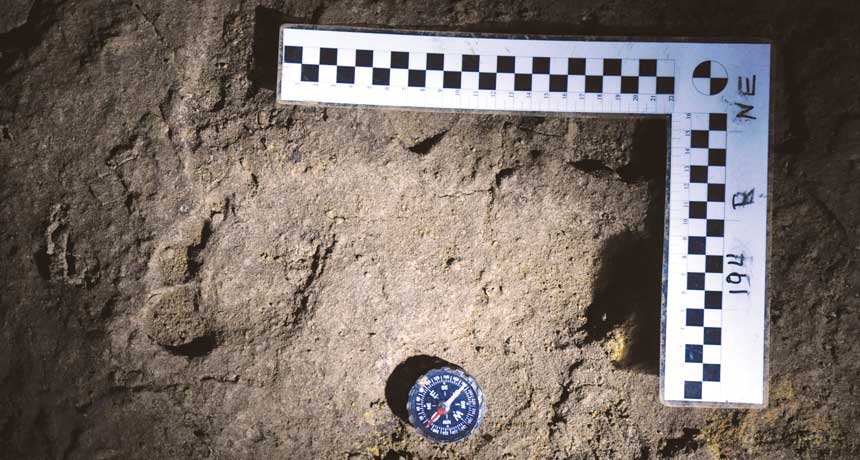Newly dated footprints: Oldest human tracks?
Scientists have just revised upwards by some 20,000 years how old they think these human footprints are

This is one of hundreds of human footprints found in a Romanian cave a half-century ago. Scientists have now given them a new and much older date: from around 36,500 years ago.
D. WEBB
By Bruce Bower
Footprints found a half-century ago in a cave in Romania may be the oldest such human impressions in Europe, researchers now conclude. They may even be the oldest in the world. But there’s a bit of controversy about that.
In 1965, about 400 footprints were discovered in the Ciur-Izbuc cave. Scientists back then attributed the prints to a man, woman and child who lived 10,000 to 15,000 years ago. But new radiocarbon measurements have dated the age of two bones from a cave bear found nearby. They were unearthed from just below the human footprints. These bear bones now indicate that those people would have lived in the Stone Age, around 36,500 years ago. Or so anthropologist David Webb of Kutztown University in Pennsylvania and his co-workers now report.
Of the original footprints in the cave left by modern humans — also known as Homo sapiens — only 51 remain. Cave explorers and tourists had destroyed the rest. Webb’s team analyzed those remaining footprints. They now appear to come from six or seven individuals, including at least one child. All entered the cave after a flood had coated the floor with sandy mud. The researchers describe their analyses July 7 in the American Journal of Physical Anthropology.
The formally published ages of other ancient footprints from Homo sapiens in Europe and elsewhere go back no more than 33,000 years. That makes the Romanian ones the oldest to be described in a journal. But some researchers think they’ve seen far older footprints.
At a 2011 conference, for instance, scientists reported finding ancient human footprints in Tanzania. The East African site where they were discovered, Engare Sero, is believed to be 120,000 years old. But a formal report of those prints has not been published yet in a journal. Webb now wonders why. Perhaps, he says, some problem arose with dating the footprints or proving they are authentic to that site.
And much older prints emerged recently — and quite briefly — on a British beach. They were not from Homo sapiens, though. Scientists believe they came from some other hominid. It would have been a very ancient ancestor of modern humans. Before the British prints washed away, scientists estimated they were nearly 1 million years old.
Power words
anthropology The study of humankind. A social scientist who studies different societies and cultures is called an anthropologist.
fossil Any preserved remains or traces of ancient life. There are many different types of fossils: The bones and other body parts of dinosaurs are called “body fossils.” Things like footprints are called “trace fossils.” Even specimens of dinosaur poop are fossils.
hominid A primate belonging to an animal family that includes humans and their fossil ancestors.
Homo A genus of species that includes modern humans (Homo sapiens). All had large brains and used tools. This genus is believed to have first evolved in Africa and over time its members continued to evolve and radiate throughout the rest of the world.
radiocarbon dating A process to determine the age of material from a once-living object. It is based on comparing the relative proportion, or share, of the carbon-12 to carbon-14. This ratio changes as radioactive carbon-14 decays and is not replaced.
Stone Age A prehistoric period, lasting millions of years and ending tens of thousands of years ago, when weapons and tools were made of stone or of materials such as bone, wood, or horn.
trace fossil Evidence other than a preserved carcass or bones of ancient life. Footprints, burrows or chew marks on a bone are examples of such trace fossils. These can provide information that’s more valuable than body fossils. For instance, trace fossils can hint at a creature’s behavior. Evidence of that is usually scant.







